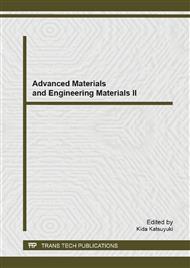[1]
Liu Yanxia, Chen Gaixin, Lu Yihui: submitted to Journal of Hydroelectric Engineering, Vol, (1)(2011), p.139. (In Chinese).
Google Scholar
[2]
Niu Ditao, in: Durability and Service Life Prediction of Concrete Structures, edited by Science (2003), in press. (In Chinese).
Google Scholar
[3]
Shi Shisheng: submitted to Civil Engineering Journal, Vol, 30(4)(1997), p.35. (In Chinese).
Google Scholar
[4]
Cheng Hongqiang: submitted to Henan Science, Vol, 21(2)(2003), p.214. (In Chinese).
Google Scholar
[5]
Li Jinyu, Cao Jianguo, Xu Wenyu: Journal of Hydraulic Engineering, Vol, (1)(1991), p.41. (In Chinese).
Google Scholar
[6]
Guo Zhenhai, in: The Concrete Strength and the Constitutive Relationship - Principles and Applications, edited by China Building Industry (2004), in press. (In Chinese).
Google Scholar
[7]
Song Yupu, in: Constitutive Relationship and Failure Criterion of a Variety of Concrete, edited by China Water Conservancy and Hydropower (2002), in press. (In Chinese).
Google Scholar
[8]
Ausloos M, Salmon E, Vandewalle N: submitted to Cement and Concrete Research, Vol, 29(2)(1999), p.209.
Google Scholar
[9]
Penttala V: submitted to Cement and Concrete Research, Vol, 32 (2002), p.1407.
Google Scholar
[10]
Li Yiqiang, Wang Xinmin, Chen Shitong: submitted to Technology of Highway and Transport, Vol, 22(10)(2005), p.75. (In Chinese).
Google Scholar
[11]
Zuber B, Machand J: submitted to Cement and Concrete Research, Vol, 30 (2000), p. (1920).
Google Scholar
[12]
Wang Licheng, Liu Hanyong: submitted to Journal of Hydraulic Engineering, Vol, 37(2)(2006), p.189. (In Chinese).
Google Scholar
[13]
Qin Liqun, Song Yupu, Chen Haoran: submitted to Chinese Journal of Rock Mechanics and Engineering, Vol, 24 (10)(2005), p.1740. (In Chinese).
Google Scholar
[14]
Song Yupu, Shen Jina, Jin Guoli: submitted to Journal of Dalian University of Technology, Vol, 32 (4)(1992), p.460. (In Chinese).
Google Scholar
[15]
Gao Lubin, in: Concrete Constitutive Theory, edited by Xi'an Jiao Tong University (1993), in press. (In Chinese).
Google Scholar
[16]
Yao Jawei, Qin Liqun, Song Yupu: submitted to Concrete Vol, (3)(2011), p.25. (In Chinese).
Google Scholar


